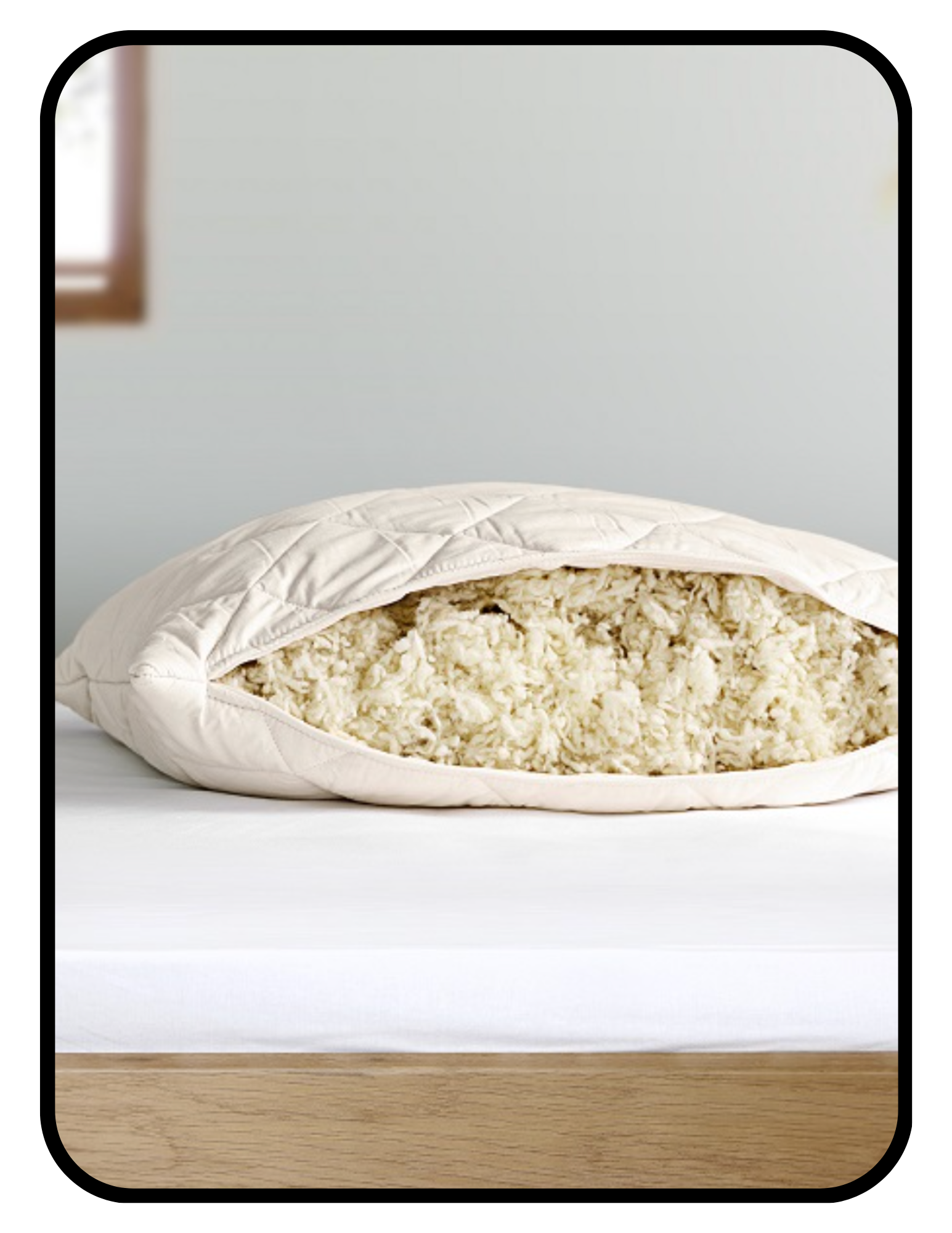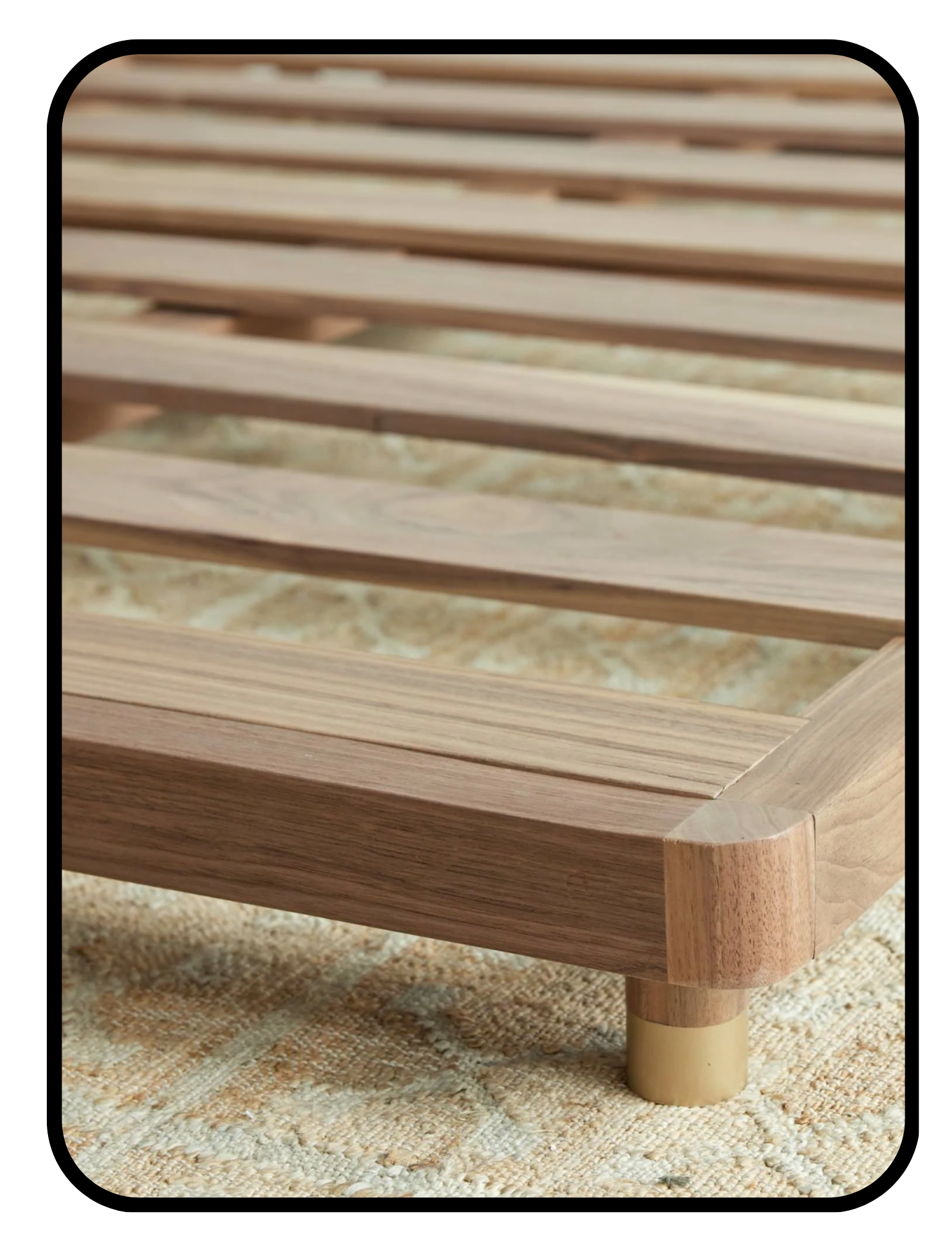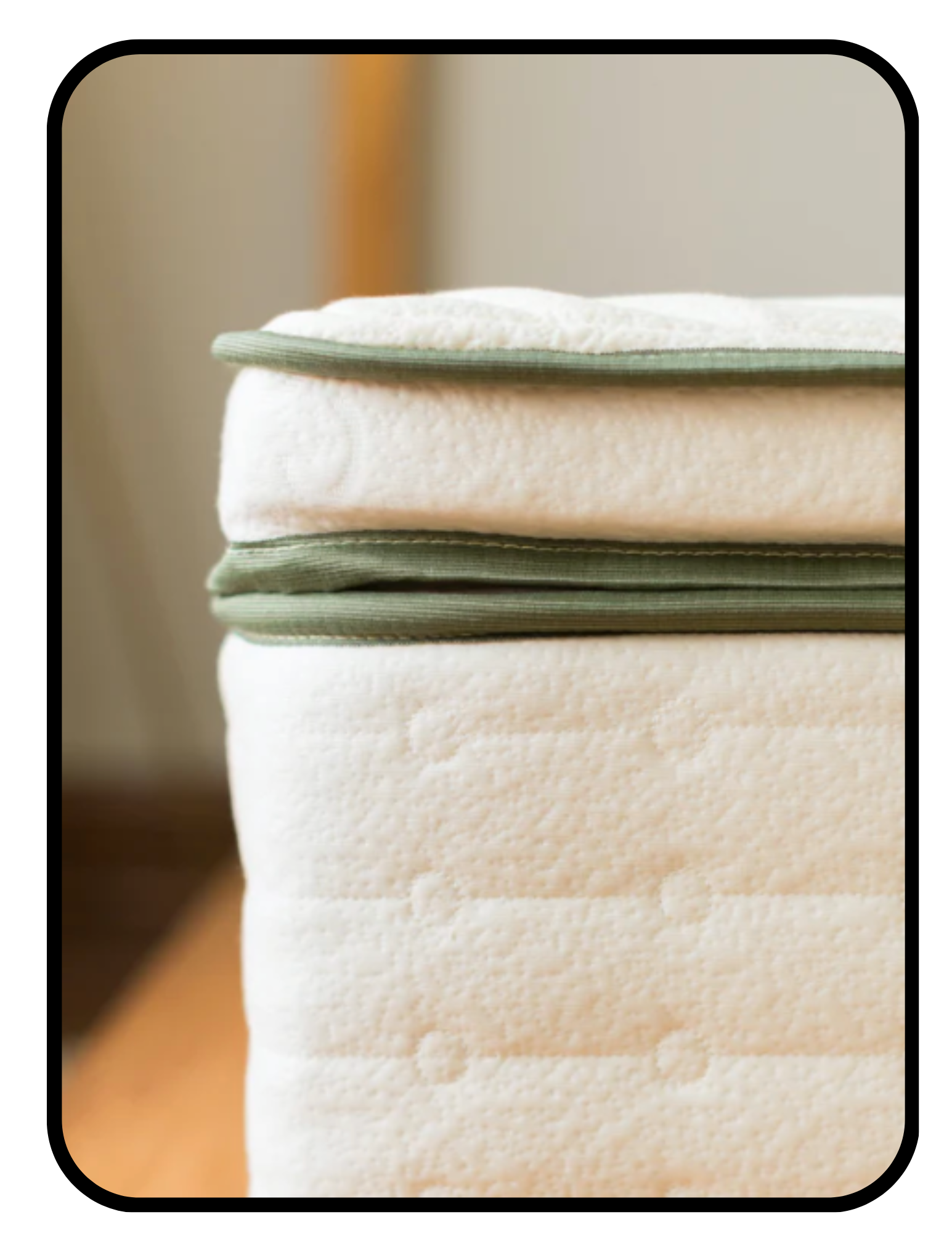Shop by Room ➜ Bedroom ➜ Pillows
Non Toxic Pillows
The best organic bed pillows, body, wedge, knee, nursing, and pregnancy pillows. Click the rating symbols below each pillow for more information about its material health.
Natural Latex Pillows
My Green Mattress makes the best organic latex pillow for two reasons— it is the only version made entirely from truly 100% GOLS certified organic latex (most use a blend), and it’s also the most affordable. It’s wrapped in GOTS certified organic cotton making it the best natural memory foam pillow alternative because this kind of latex (Dunlop) has a firm, but springy and supportive feel.
Savvy Rest
Savvy Rest’s pillow is so soft because it’s made with C2C certified Talalay latex instead of Dunlop latex (which is firmer.) This is the best natural pillow for side sleepers— I sleep on Talalay on love it. It’s super supportive, and you get just the right amount of both springiness and that cozy sinking-in feeling. Wrapped in an organic cotton cover and comes in Standard, Queen, and King sizes.
Avocado’s natural latex pillow is a little firmer than Talalay and made with charcoal-infused natural rubber latex. It has OEKO TEX certification, meaning it has been tested for harmful chemicals. The outer lining is super soft, and made of GOTS certified organic cotton. This is another great non toxic memory foam pillow alternative.
Naturepedic’s latex pillow is made with a combination of GOLS certified organic latex and FSC certified latex, which is not organic, but is natural and sustainable. A non toxic pillow far better than memory foam and just as comfortable (more so, in my opinion.) Wrapped in a GOTS certified organic cotton cover.
Adjustable Pillows
Avocado
This is a combination of latex and kapok fiber— Dunlop latex comes from the rubber tree and kapok from the kapok tree. Both are fully GOLS and GOTS certified. The case is made of organic cotton, and the filling is adjustable, so you can pull out or add in filling to your comfort level, making it the best organic pillow for side sleepers, the best organic pillow for back sleepers, and the best organic pillow for stomach sleepers if you like to tailor your puffiness perfectly. Comes in a regular rectangular shape or an ergonomic side-sleeper option.
This pillow has a combination of firmer and softer latex — GOLS certified organic Dunlop latex mixed with softer C2C certified Talalay. Add or remove filling to make it the perfect height non toxic pillow for your preference. The outer casing is made of organic cotton.
This is a combination of 90% latex and 10% cotton and it won the Good Housekeeping award for best overall organic pillow in 2023. It holds its shape well, and is breathable. The latex is a blend of GOLS certified organic and FSC natural latex. The outer casing is removable, machine washable, and made of GOTS certified organic cotton. Comes in standard, Queen, and King sizes and several firmness options.
This pillow is a mixture of 75% shredded latex and 25% organic wool. They have C2C and GOTS certificates ensuring it’s healthy. I love wool for sleeping because it’s thermoregulating and moisture wicking, making this the best organic pillow for hot sleepers. It arrives intentionally overstuffed, so you can remove as much as you want to make it the perfect height.
Best Wool Pillows
Naturepedic’s 100% organic wool pillow is thermoregulating, breathable, and holds its shape well because they use small woolen puff balls instead of standard wool batting. Encased in a super-soft organic cotton cover.
IKEA
IKEA makes an all-natural wool pillow with an undyed cotton outer. Not organic, and no health certifications, but still a far healthier option than standard, and the most affordable wool pillow available.
Parachute’s down pillow is filled with 85% down clusters and 15% feathers, and comes in soft, medium, and firm options for side, back, and stomach sleepers. The outer case is 100% cotton and the whole thing is Class 1 OEKO TEX certified meaning healthier processing. The down is certified humane, as well.
Naturepedic’s down pillow is filled with 75% down clusters and 25% feathers. It’s encased in an organic cotton outer that is OCS100 certified, which means it’s made with at least 95% organic cotton, and MADE SAFE ensures healthier processing of the cotton than standard. The down is certified humane.
Best Down Pillows
Other Non Toxic Pillows
This pillow is stuffed entirely with fluffy kapok fiber that comes from the pods of the kapok tree. It’s moisture wicking, quick-dyring, and bouncy. Fluffable, this is Savvy Rest’s most popular pillow and comes with lots of great reviews. A very soft organic pillow, kapok filling is an organic and vegan alternative to down. It’s adjustable, so you can add or remove kapok as needed to make the pillow the right height for you.
This is made from PLA. Short for polylactic acid, the PLA from Naturepedic comes from non-GMO sugarcane. Considered a plant-based bioplastic, it’s similar to polyester, but naturally derived, vegan, and makes a great down alternative. This Naturepedic pillow is moisture wicking, cooling, and wrapped in OCS certified cotton, which means at least 5% of the cotton is organic. It’s a MADE SAFE certified non toxic pillow.
Parachute’s down alternative pillows are made with a microfiber filling and encased in cotton. They can be a good option if you have allergies to latex, wool, or down. Importantly, they are OEKO TEX certified, ensuring minimal chemicals were used in the processing. A much healthier pillow than foam, memory foam, or uncertified polyester. Options for pillows for side sleepers and back sleepers.
Made with natural Talalay latex and a nylon encasement, SIJO strikes a nice balance between imperfect but better materials, at a more affordable price. Importantly, the entire pillow is OEKO TEX certified.
Naturepedic offers one body pillow made with PLA (a plant-based semi-synthetic fabric stuffing made from sugarcane) and wrapped in a OCS100 cotton sateen casing, meaning 95% of the fibers are organic. MADE SAFE ensures the fibers were processed with less toxic chemicals. You can pair it with one of their sateen pillowcases.
Tuft and Needle’s body pillow is stuffed with a polyester filling and encased in 100% cotton. Importantly, it is Class 2 OEKO TEX certified, making it a step up from uncertified options. It’s also a more affordable body pillow than the other options listed, if you’re looking to balance health and cost. You can get one of their quilted percale cotton covers to go with it.
Organic Body Pillows
Savvy Rest
Savvy Rest offers 4 different kinds of organic and natural body pillows— choose between organic kapok, natural wool, certified natural latex, or a wool-latex blend. They come intentionally overstuffed so you can remove filling to your comfort level. All are cased in organic cotton, and you can choose whether or not you also want the organic waterproof pillow protector, and if you want a flannel or sateen pillow case.
As the name implies, the Holy Lamb Organics body pillow is stuffed with GOTS certified organic wool, and encased in GOTS certified organic cotton sateen fabric. An excellent completely organic body pillow choice. Comes in two sizes; the usual 17x53” for adults, or a 9x42” for kids or smaller adults.
Obasan makes a detachable two-sided pillow system for pregnancy that is perfect if you alternate sleeping on either side throughout the night. It’s filled with GOTS certified organic wool and is cased in organic cotton, and the two pillows can be unzipped and used as support pillows post-partum for a variety of functions.
Holy Lamb Organics makes a completely organic nursing pillow filled with GOTS certified organic wool and made with a removable organic cotton casing. You can order more casing for easy washing. They also have a natural wool option if you’re looking to balance cost but still have a totally natural nursing pillow.
Also called an organic reading pillow, this wedge pillow from Avocado is completely organic, made of GOTS certified organic latex and cotton. It comes with a washable removable cover, an option to add a waterproof encasement, and of course, wedge shaped pillowcase options. Can also be used to reduce snoring, or even prop up your legs. Generally super-versatile for comfort.
Organic Knee and Leg Posture Pillow
Woolroom offers a V-shaped pillow made from GOTS certified organic washable wool stuffing and an unbleached 300 thread count organic cotton casing. Can be used as a pregnancy pillow, or for general knee, leg, and posture support while sleeping.
Other Ergonomic Pillows
More Healthy Design For You
More About Non-Toxic Pillows
Are organic pillows worth it?
Yes! Your pillow is probably the object you’re in the closest contact with in your entire house — even your toothbrush you only spend a few minutes with every day. Meanwhile, your pillow is snuggled right up against your face for one third of your life, including your nose and mouth, which of course lead to your airway and gut. With skin contact as well, the materials its made of have a huge impact on your health. For these reason, I even recommend buying organic pillows before investing in an organic mattress when budgeting is a concern.
Are memory foam pillows toxic?
Yes, most likely. While I’m tempted to say with certainty that all PU foam is toxic, I can’t quite say 100% yes because of the lack of transparency in the ever-changing ingredients lists. The lists are considered a proprietary secret, so that different companies can create different textures and types of foam without being copied. The little that we do know about the ingredients is unflattering when they are revealed, and they keep changing in reaction to updated health and environmental policy rules. For example, the blowing agents used in foam manufacturing changed in 2020 from hydrofluorocarbons (HFCs) to hydrofluoroolefins (HFOs) because HFCs were causing environmental harm (now, the new HFOs may be banned because they qualify as a forever chemical in some states). The main catalyst used in foam, stannous octoate, was declared a reprotoxic 1B chemical that may damage unborn children (fetuses) and some (not all) foam started being made without it in 2023. Flame retardants are no longer allowed in some foam in some states as we’ve learned how harmful they are to the human body and the environment. The level of VOCs foam emits is also lower now than it used to be, because consumers were bothered by the fact that foam off-gasses toluene, xylene, and acetone, among many other compounds, and the industry adjusted to make their foams less smelly. While all of the above certainly qualifies foam, in my opinion, as 100% yes, toxic — if you choose foam made without any of these things, is it still toxic? My hunch is: probably! There are very likely more unsavory chemicals being used in it now that we may discover and ban in the future. But, without knowing what they are, and how they interact with the body, I can’t say for sure. For this reason, I practice the Precautionary Principle with foam, and avoid it as often as I can.
How do foam chemicals get into my body?
There are two ways chemicals leave the foam, and three ways they get into your body:
The two ways chemicals leave the foam are into the air and into dust. Polyurethane foam (including memory foam) is made with 2 chemicals as the main building blocks, polyols and isocyanates (see more above). They bond together very tightly, so other additives in foam (like flame retardants and other propriety chemical ingredients) are integrated, but only temporarily— they’re not bonded together tightly, and over time, as foam degrades via friction, they fall out. If they’re lightweight, they can be suspended in dust in the air, and if they’re heavier (like flame retardants are) they settle into dust on the ground. The other way chemicals get out of mattresses is by being volatile— so, a VOC or odor— these are lighter than air. The “new mattress” smell comes from foam and the adhesives used to keep the layers together, and they can off-gas VOCs for quite some time.
The three ways these chemicals get into your body are through inhalation, ingestion, and absorption. You inhale and ingest VOCs and lightweight chemicals suspended in the air — they come in through your breathing passages and are swallowed, as well. You ingest about 50mg of dust daily (children ingest 100mg daily!) by touching dusty surfaces and hand-to-mouth contact. Finally, flame retardants and other chemicals are very small and as they make their way out of mattresses, can pass through skin and be dermally absorbed.
What does GOTS certified mean?
GOTS is short for the Global Organic Textile Standard.
It is the gold standard 3rd party certification for organic fabrics made from natural fibers like wool, cotton, linen, and others.
Fabric with the GOTS-certified organic label means that at least 95% of the starting fibers are certified organic, and ensures that the fabric remains healthy throughout the entire manufacturing process. This means the dyes and other chemicals used are safer for human and ecological health than standard fabric processing methods. No harmful finishes may be added to the final product.
What is OEKO TEX?
OEKO TEX certification applies to the finished product only, and is for both natural and synthetic textiles. Organic fibers, as well as man-made fabrics like polyester can both qualify, depending on what chemicals, and how much of them, are left in the final product. It does allow for some harmful chemicals, but in much lower quantities than are used in standard textile processing. You can see their limits, which are updated annually, here.
What is latex?
Latex is the same thing as natural rubber. It comes from the Hevea brasiliensis tree. It is a milky white liquid that can be baked to form a springy, foam-like substance. It is often confused with synthetic (lab-made) latex, which is the chemical mixture styrene-butadiene.
What is Dunlop latex? How is Dunlop latex foam made?
First, the latex must be from an organic latex tree farm, grown without pesticides. The latex rubber “milk” from the tree is poured into a mold, mixed with Zinc, Sulfur, and soaps to make it a “gel,” then is baked into shape. It’s washed to remove impurities, and then is baked again to dry it out. This process has been used for about 100 years, and the result is a dense foam. To meet the the GOLS standard, it must be composed of at least 95% organic latex. Because the Dunlop process uses minimal ingredients, and is from organic trees, it can meet this requirement.
What is Talalay latex? How is Talalay latex foam made?
To make a less dense, softer, latex foam, the Talalay method was created in the 1940s. The natural rubber “milk” is poured into a mold, but only filled partway. At this point, chemicals are added to the mixture, and a vacuum seal is applied so that the foam puffs up and the air pockets are dispersed evenly. Then, it is flash-frozen with carbon dioxide to hold its shape, and baked. This process makes an airier foam than Dunlop, which is how it gets its softness.
Talalay latex isn’t organic, so cannot be GOLS certified. This can be OK, and truly natural Talalay is a fantastic choice compared to regular polyurethane foam. The only issue is that some manufacturers do not disclose what additives are used. Unfortunately, and confusing to many, this can still be sold as “100% natural latex,” even with additives.
Unless they have third party certification! Look for ecoINSTITUT, or C2C Gold or Platinum, certification, which ensures that 100% of the ingredients have been disclosed and confirmed that they are safe for humanhealth. If you are choosing a mattress made with Talalay, make sure the company states exactly where it is from, and if it has legitimate certifications like C2C or ecoINSTITUT.
Finally, because Talalay is less dense than Dunlop, a large single sheet (the size of a mattress, for example) is harder to achieve. Instead, several smaller pieces may be glued together. This can be avoided by mattresses that come in slabs that you stack yourself. Or, some brands will use safe adhesives, even sometimes using a liquid version of latex.
To sum it up, Talalay can sometimes be almost as healthy as Dunlop, but you have to make sure it was processed correctly, and that the company isn’t using it as a healthwashing technique.
Shop by Room ➜ Bedroom ➜ Pillows









































